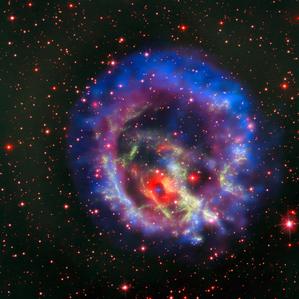Glossary term: Supernova
Description: A supernova is a massive stellar explosion. Supernovae briefly become by far the most luminous object in their galaxy before fading over the course of a few years. There are two main pathways that lead to supernovae. The first (Type Ia) involves a white dwarf accreting matter from a binary companion star. Once the white dwarf is destabilized, either by achieving a mass of over 1.4 solar masses (known as the Chandrasekhar limit) or by accumulating enough helium on its surface, it explodes, leaving no remnant. The other main pathway that forms a supernova (Type II) is the evolution of a star with a mass greater than eight solar masses. At the end of such a star's evolution it explodes, resulting in a neutron star or (for the most massive stars) a stellar-mass black hole.
Supernovae are the source of many of the chemical elements, especially those heavier than magnesium.
Related Terms:
- Binary Star
- Black Hole
- Neutron Star
- Nova
- Solar Mass
- Stellar Remnants
- White Dwarf
- Gamma Ray Burst
- Standard Candle
See this term in other languages
Term and definition status: This term and its definition have been approved by a research astronomer and a teacher
The OAE Multilingual Glossary is a project of the IAU Office of Astronomy for Education (OAE) in collaboration with the IAU Office of Astronomy Outreach (OAO). The terms and definitions were chosen, written and reviewed by a collective effort from the OAE, the OAE Centers and Nodes, the OAE National Astronomy Education Coordinators (NAECs) and other volunteers. You can find a full list of credits here. All glossary terms and their definitions are released under a Creative Commons CC BY-4.0 license and should be credited to "IAU OAE".
If you notice a factual error in this glossary definition then please get in touch.
Related Media
Death of a massive star
Credit: ESO/NASA, ESA and the Hubble Heritage Team (STScI/AURA)/F. Vogt et al. credit link
License: CC-BY-4.0 Creative Commons Attribution 4.0 International (CC BY 4.0) icons









